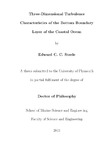Three-Dimensional Turbulence Characteristics of the Bottom Boundary Layer of the Coastal Ocean
| dc.contributor.supervisor | Nimmo-Smith, W. Alex M. | |
| dc.contributor.author | Steele, Edward C. C. | |
| dc.contributor.other | Faculty of Science and Engineering | en_US |
| dc.date.accessioned | 2015-07-24T14:18:30Z | |
| dc.date.available | 2015-07-24T14:18:30Z | |
| dc.date.issued | 2015 | |
| dc.identifier | 10110028 | en_US |
| dc.identifier.uri | http://hdl.handle.net/10026.1/3459 | |
| dc.description.abstract |
The form and dynamics of ocean turbulence are critical to all marine processes; biological, chemical and physical. The three-dimensional turbulence characteristics of the bottom boundary layer of the coastal ocean are examined using a series of 29,991 instantaneous velocity distributions. These data, recorded by a submersible 3D-PTV system at an elevation of 0.64 m above the seabed, represent conditions typical of moderate tidal flows in the coastal ocean. A complexity associated with submersible 3D-PTV in the coastal ocean is that gaps and noise affect the accuracy of the data collected. To accommodate this, a new Physics-Enabled Flow Restoration Algorithm has been tested for the restoration of gappy and noisy velocity measurements where a standard PTV or PIV laboratory set-up (e.g. concentration / size of the particles tracked) is not possible and the boundary and initial conditions are not known a priori. This is able to restore the physical structure of the flow from gappy and noisy data, in accordance with its hydrodynamical basis. In addition to the restoration of the velocity flow field, PEFRA also estimates the maximum possible deviation of the output from the true flow. 3D-PTV measurements show coherent structures, with the hairpin-like vortices highlighted in laboratory measurements and numerical modelling, were frequently present within the logarithmic layer. These exhibit a modal alignment of 8 degrees from the mean flow and a modal elevation of 27 degrees from the seabed, with a mean period of occurrence of 4.3 sec. These appear to straddle sections of zero-mean along-stream velocity, consistent with an interpretation as packets. From these measurements, it is clear that data collected through both laboratory and numerical experiments are directly applicable to geophysical scales – a finding that will enable the fine-scale details of particle transport and pollutant dispersion to be studied in future. Conditional sampling of the Reynolds shear stress (without using Taylor’s hypothesis) reveals that these coherent structures are responsible for the vertical exchange of momentum and, as such, are the key areas where energy is extracted from the mean flow and into turbulence. The present study offers the first assessment of the magnitude of the errors associated with assuming isotropy on shear-based sensors of the TKE dissipation rate and its consequential effect on the Kolmogorov microscale using 3D-PTV data from the bottom boundary layer of the coastal ocean. The results indicate a high degree of spatial variability associated with the low conditions. The averaged data supports the validity of measurements obtained by horizontal and vertical profilers, however along-stream velocity derivatives underestimate the TKE dissipation rate by more than 40% – a factor of two higher than for the equivalent cross-stream and vertical estimates. This has important implications for the deployment of these sensors and the subsequent interpretation of higher-order statistics. Finally, the data have been processed to test four popular sub-grid scale (SGS) stress models and SGS dissipation rate estimates for Large-Eddy Simulations using these in situ experimental data. When the correlation and SGS model coefficients are assessed, the nonlinear model represents the best stress models to use for the present data, consistent with the substantial anisotropy and inhomogeneity associated with these flows. The detailed measurement and analysis of coherent structures in the coastal ocean undertaken therefore supports the development of numerical models and assists with the understanding of all marine processes. | en_US |
| dc.language.iso | en | en_US |
| dc.publisher | Plymouth University | en_US |
| dc.subject | 3D-PTV measurements | en_US |
| dc.subject | Bottom boundary layers | en_US |
| dc.subject | Coherent vortical structures | en_US |
| dc.subject | Turbulence | en_US |
| dc.title | Three-Dimensional Turbulence Characteristics of the Bottom Boundary Layer of the Coastal Ocean | en_US |
| dc.type | Thesis | |
| plymouth.version | Full version | en_US |
| dc.identifier.doi | http://dx.doi.org/10.24382/4524 |
Files in this item
This item appears in the following Collection(s)
-
01 Research Theses Main Collection
Research Theses Main


